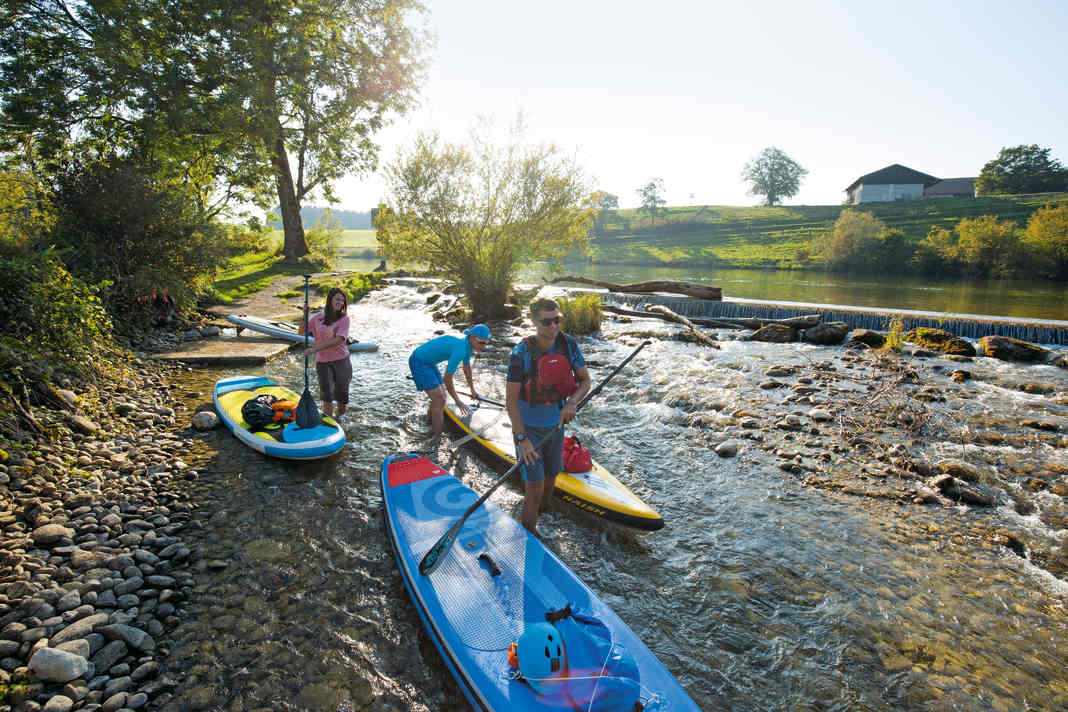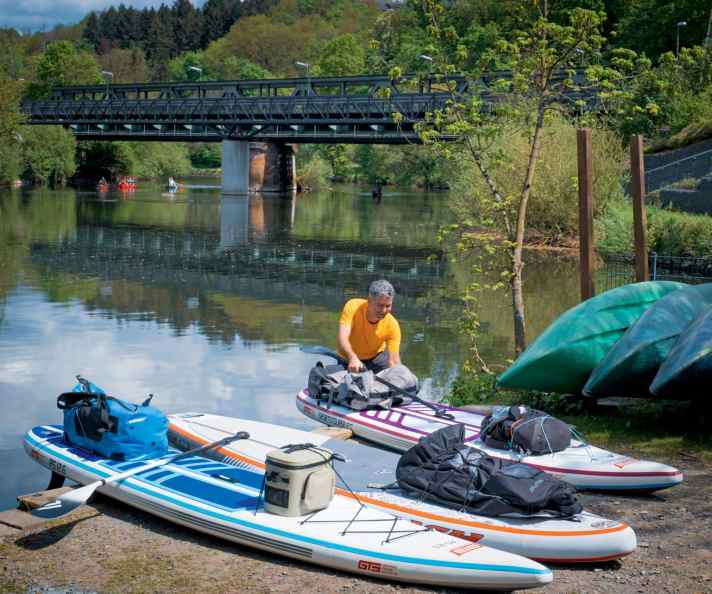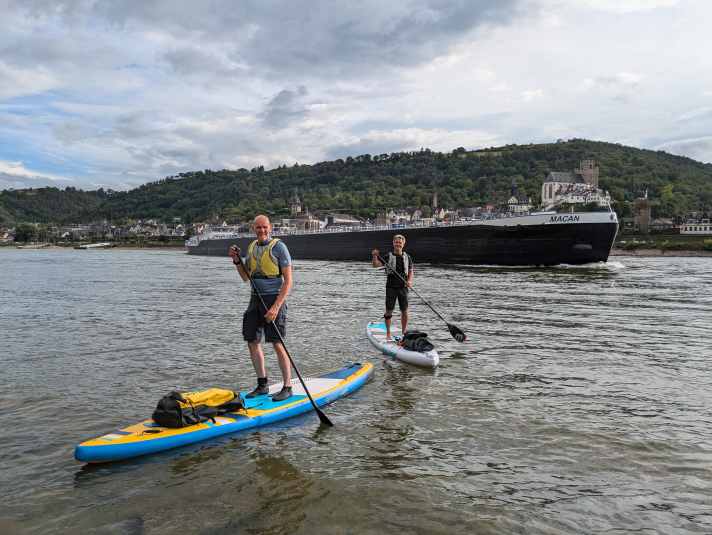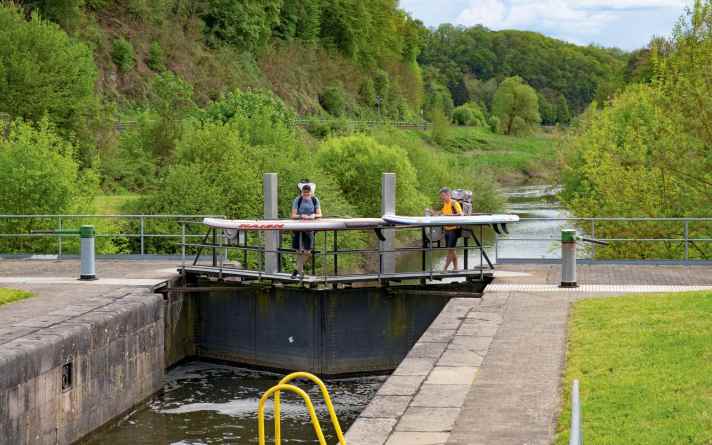Tour planning: How to organise a river tour with the SUP - the best tips to save stress






Something like this has just happened to our colleagues from the SUP editorial team: The Fränkische Saale before Gemünden was on the paddling programme. Possible navigation bans had been checked (closures from 2022 had been lifted again) - but nobody felt responsible for the water level and water depth. Luckily, the team had missed the shuttle train and noticed that the water level was too low in long sections during the car transfer upstream. Also fortunately, the Main is "right next door" and the Saale tour at least turned into a nice short trip on the Main.
That's why I plan new, unknown tours in great detail. In addition to choosing the route, I also take into account the wind and weather forecast, possibly the water levels in the river and the expected conditions on the water, select the equipment accordingly and check it before starting the tour. A simple memory aid helps me to optimise my tour planning:
W - Weather, wind, water
A - Equipment
S - Route
S - Safety
E - Exploration/Elements/Experience
R - Rules
Selecting a suitable route: river as a one-way street
Who is in the group? How fit are the individual group members? Every tour should be based on the fitness and ability of the "weakest" group member. Especially with children and teenagers, you should not overestimate their mental stamina on long tours. With SUP beginners, it is best to choose a small lake and paddle along the shore to make the introduction to SUP as easy as possible and to ensure safety. Whether you want to paddle on a river or a lake has a huge impact on the tour planning. On a river tour, the start and finish points are different, as you will almost always only be paddling in one direction with the current and therefore the transport of equipment and people (known as "shuttling") must be planned and organised.

Examples of river tours with the SUP
Logistics for SUP tours on the river
For example, it is possible to deposit a bike at the destination in advance, which the fittest person then uses to pick up the car. Large groups often use two cars, one of which is also parked at the destination in advance. Ideally, there will be a nice beer garden where the other paddlers can wait. If the river is very meandering, the direct route by bike is often much shorter than along the Main, for example. The most relaxed way is often to take a leisurely bus or train journey with boards and pumps as hand luggage. It is often possible to cover at least one stretch by public transport. Large rivers are often accompanied by the railway line and numerous campsites directly on the banks are ideal as a start/finish point.

My favourite tours end directly at a campsite. To start, I head upstream in the morning with my board on the cable car." (Stephan Gölnitz, surf editor)
If you take public transport for the outward journey, you have more time flexibility on the tour. I also check the entry and exit points in advance (e.g. publicly accessible areas, bathing beaches, seaside resorts, harbours and slipways) and whether the board has to be carried far to the water. Especially in cold weather, I choose the entry points so that I can get on the board with as dry a foot as possible - via a jetty or a place with a large water depth where the board does not touch down with the fin. Also important: Can you get on the board barefoot or with neoprene shoes? Or do you need shoes with a sturdy sole, for example on a steep slope?

Two cars, train or bike
When choosing a route, I always pay attention to highlights worth seeing along the way and research good places to rest and stop for refreshments. Is there anything better than enjoying a refreshment in a sunny beer garden with a view of the water? When getting on and off the river or taking a break, you should check whether the riverbanks are open to the public. For example, the banks in the Spreewald are mostly private property, which makes access impossible in some cases. If in doubt, ask in advance.
Not all banks are open to the public like in the Spreewald, for example." (Thomas Pfannkuch, SUP sailor)
If you are planning a river tour, you should take into account how many points of diversion there are along the course of the river (e.g. due to weirs or impassable points) - and how these can be bypassed. Is a boat trolley necessary for longer stretches? Depending on the water level, a river can change dramatically and make paddling difficult or impossible. On river tours, the length of the route, the water level and the flow speed have a huge impact on the duration of the tour. Our tour on the Amper for SUP Mag 2020 showed that it's possible to get things wrong. With numerous photo stops and a long break in the beer garden, we only arrived at our destination in the dark. Conclusion for next time: leave earlier! Generally speaking, you shouldn't paddle rivers without specialised knowledge of running water and equipment.

Locks and shipping routes
When touring the lake, you should avoid the busy excursion boat routes. Moorings must be avoided as far as possible. On the sea, currents and waterways must be taken into account. Registered (and buoyed) shipping lanes may not be crossed with the SUP. The German Canoe Association (kanu.de or Canua App) provides the rules of the road - which routes or areas are closed at the time of the tour, primarily to protect nature and the environment. Locals and SUP centres also serve as sources of information on local rules, as do the authorities that issue regulations for the respective waters. Books (also from the canoeing sector), blogs and websites, tourism associations - and of course SUP magazines, which also present fantastic tours - are also helpful for planning tours.
Travelling through locks on a SUP is generally prohibited, but these can usually be easily avoided.

Wind, weather and water
Rain or snow, wind or storm: nobody likes to leave the house when it's raining - and usually not for stand-up paddling either. Unless you want to start a downwinder in the wind or fly over the water with a wing. You have no business being on or in the water during thunderstorms anyway.
That's why it's important to check the weather and wind conditions before every SUP tour - for the entire duration of the tour. It's best to check the weather forecast a few days in advance to see whether and how stable the forecast is or how it changes. At the starting point of the tour, I recommend a final weather check via app before you head out on the water. On the edge of the Alps, for example, I notice time and again that the weather forecast is not always correct and that local influences have a strong impact on the weather, even at short notice. On a tour on Lake Chiemsee in March, the wind was supposed to pick up in the afternoon - and then: calm and no wind. Good for us!
The wind in particular has a big influence on paddling. Therefore, the basic rule is - if the spot allows it: Paddle into the wind first and then paddle back to the starting point with a tailwind when the wind drops. If the wind is too strong, you should not go out on the water at all. Offshore winds (especially at sea) increase the potential danger. In windy conditions, the water surface is also much more turbulent, which makes paddling even more strenuous and challenging.
There are numerous websites and apps for weather forecasts - some better, some worse. I don't rely on one app for the wind and weather forecast, but use different apps and compare the values. For me, the WetterOnline app, the WarnWetter app from the DWD (including storm warnings for German inland waters), Agrarwetter and, for southern Germany, the app from the Central Institute for Meteorology and Geodynamics (ZAMG) in Austria are at the top of the list. However, the classic weather apps usually only offer a rough wind forecast. Specialised wind apps for water sports enthusiasts, on the other hand, show spot-based current values and an hour-by-hour forecast of the average wind speed and wind peaks - from different weather models. They are therefore the better alternative for paddlers. Windy and Windfinder are my app tips here. Another useful tool is webcams, which make it easy to check the situation on site. In winter, for example, I wanted to go to the Staffelsee. It's a good thing I checked the webcam beforehand. Most of the lake was already frozen over and therefore no longer paddleable.
While the water level plays a special role on river tours and many tours are only possible from a minimum water level, waves, tides and currents influence tour planning at sea. To check the water level for the river of your choice, which must be neither too low nor too high, we recommend installing the apps "RiverApp" and "Meine Pegel" on your smartphone. The RiverApp in particular is extremely helpful as it displays the low, medium and high water levels as well as the whitewater levels for sections of the route and makes it easier to assess whether a river can be paddled or not. For paddlers at sea, Magicseaweed provides detailed information on the relevant values.
Personal equipment - safety, clothing, useful equipment
All that remains is the equipment check: Before every tour, you should visually inspect the board and paddle. For multi-day tours or river tours, it sometimes makes sense to carry a spare fin, spare paddle in several parts and a small pump. The parts can then be divided up within the group. On a tour on the Amper near Munich, a fellow paddler's fin broke off five kilometres before the end of the tour - from then on he had a very mobile board and had little fun on the last few kilometres. A replacement fin would have been helpful!
Clothing
Clothing adapted to the water temperature - and not the air temperature - is an important safety factor. Proper clothing protects against cold shock, hypothermia or overheating. Therefore, be aware of the dangers and consequences of wearing unsuitable clothing for yourself and others (e.g. rescue workers) and choose the right clothing accordingly before the tour. It never hurts to have a change of clothes in a dry bag: for example, if you are planning a visit to a beer garden and don't want to sit there in your possibly wet sportswear - or are not allowed in at all - this also happens from time to time. Especially in summer, sun protection consisting of a shirt and hat is essential, as is sun cream. In addition, sunglasses that are attached to a floatable strap to prevent them from sinking if you jump or fall into the water.
Other useful equipment
On the lake and sea, the leash is mandatory equipment. A lifejacket (PFD) or additional buoyancy aid should also be standard equipment on any body of water. I also find it very useful to have an outdoor first aid kit, a whistle with which I can draw attention to myself in an emergency and a rope for towing (also works with a leash if necessary). All three items are stowed in my dry bag as standard to be prepared for an emergency. Speaking of dry bags: during my tours, a mobile phone with emergency numbers stored in it is always stowed in a waterproof cover. If you are travelling in a group, it is sufficient if at least one paddler has a mobile phone with them to reduce the risk of water damage. Energy bars are a good source of energy, and it goes without saying that you should take enough drinks with you for the entire tour. For a tour lasting several hours in summer, 2 litres per person is not too much. I keep additional safety equipment ready for river tours: Helmet, impact protection waistcoat, throwing line, shin guards and sturdy shoes.
Leash
- Open sea: Always (on the ankle)
- Inland lakes: Always (on the ankle, calf or hip). l
- Open flow (without stones or branches in the underwater) such as federal waterways (Rhine, Main, Moselle, Elbe...): Waist belt with panic lock, lifejacket with panic lock.
- Blocked river (Obstacles below and above the water surface such as stones, branches, trees): without leash or leash on lifejacket with panic lock. Never use a leash on your foot/leg - or without quick release - danger to life!
Useful apps
- Canua: App with comprehensive water information and for route planning. Among other things, the map clearly shows entry and exit points, bridges, transverse structures and closures.
- RiverApp: App with current and historical water levels and river gauge data. In addition, detailed information on paddleable river sections with reference values for low, medium and high water as well as white water levels.
- DWD WarnWetter: App with up-to-date local weather forecast and weather warnings. In addition, push notifications for coastal and inland lake warnings (currently only Bavarian lakes).
- Windy.app: Weather app especially for water sports enthusiasts with detailed weather forecasts, live wind map and local weather reports based on various weather models.
Clothing
- Below 10 degrees water temperature: Dry suit, warm functional clothing underneath, neoprene shoes and waterproof socks if necessary. In combination, a hat and gloves if the air temperature is between 5 and 10 degrees.
- Between 10 and 18 degrees water temperature and below 15 degrees air temperature: Dry suit, with thin functional clothing underneath, or special SUP neoprene clothing. A wetsuit also provides good protection, but is not very comfortable to wear when paddling for long periods and does not "breathe".
- Over 18 degrees water and air temperature: Shorts, shirts and swimwear made of quick-drying materials, as well as headgear, sunglasses and sun cream.
- If you are paddling without a drysuit, you should have at least one change of clothing with you in a waterproof bag.

